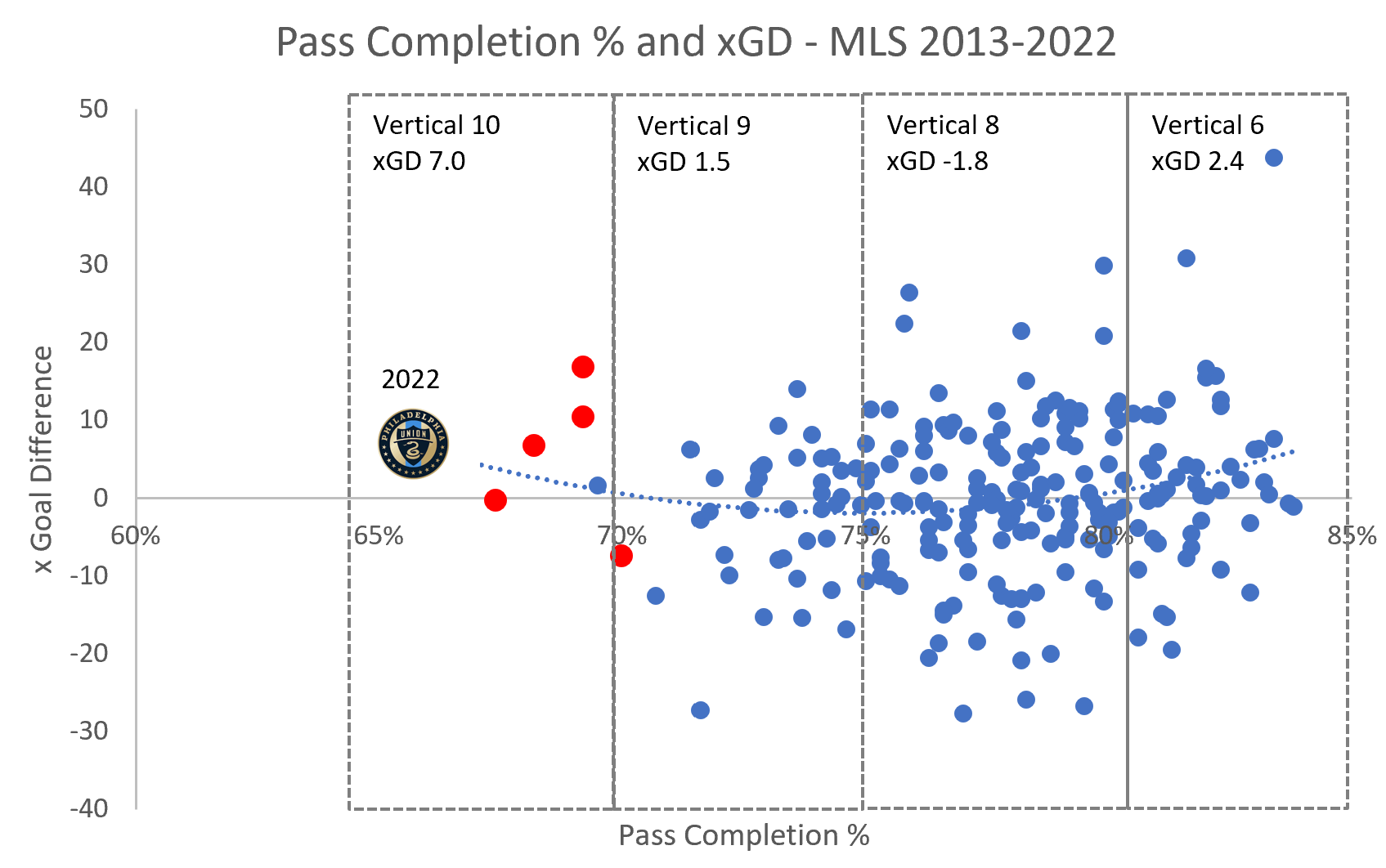Can the Philadelphia Union really be good when their passing is so bad?
/By Jared Young
The Philadelphia Union are off to their best start in team history. They sit among the league leaders with 17 points in the first eight games and have looked in control in doing so, amassing +6 xGD in the process. But a funny thing happened on the way to the top of the league table. The Union’s pass completion percentage has dropped to 66%, the worst rate in the league in the last ten years.
Pass completion rates for a team rarely exist below 70%. Only six teams accomplished that “feat” out of 228 teams that have played a league season since 2013. The New York Red Bulls have actually made such ignominy a hipster tactic since 2018, when they decided to play the most direct passing game in the league, and have completed less than 70% of their passes for four of the past five seasons.
It appears the Union have decided to follow suit.
red dots represent New York Red Bulls seasons 2018-2022, Verticality calculates how far up the field a team’s average pass reaches
As the chart shows, poor passing is not correlated at all with a poor record. The average xGD of the six low pass completion seasons is 7.0. That’s because pass completion percentage doesn’t necessary tell us about the team’s level of competence, it tells us more about how a team is trying to play. A low pass completion percentage typically indicates the team is trying to get up the pitch quickly and will attempt riskier, lower percentage passes to do so. A high pass completion percentage indicates a team is more focused on controlling possession through shorter passes, with getting up the pitch quickly a lower priority.
The Union are making a more concerted effort to play extremely direct this season, and you can see it across all of the players who played for them in both 2021 and 2022.
Data is sorted from left to right by defensive positioning and includes only players who have played in both seasons.
While the length of the passes for each of the Union players is in the same ballpark, every single player is playing more direct up the field passes, with the fullbacks the most impacted. Correspondingly, their expected pass completion percentages have all gone down. All of the players are trying more difficult passes, with lower likelihood of success.
Why Jim Curtin has dictated this change is worth some pondering. A key piece of last season’s attack, Jamiro Monteiro, was sent to San Jose in the offseason and that’s likely the impetus. Monteiro manned the 10 spot in the Union’s 4-4-2 diamond last year, and while he was probably better suited to a deeper role, he effectively provided the link between the midfield and the forwards.
Fast forward to 2022, and that role is now being played by Daniel Gazdag. Gazdag has started the season with a sparkling 4 goals and 1 assist, and that goal-to-assist ratio accurately articulates the kind of 10 he prefers to be. One could argue Gazdag plays more like a false 9 than a creative 10. The ramification is that the Union don’t have a clear possession-oriented link between their midfield and their top three.
This gap is further exacerbated by the skillset of Curtin’s central midfield. That trio of Jose Martinez, Leon Flach and Alejandro Bedoya are primarily hustle and position-oriented midfielders that cover lots of ground and focus on their defensive responsibilities first. The Union have never been a team that approached Tiki Taka, so perhaps Curtin has realized his best chance of success was to throw ideas of brilliant possession to the wind, and rather pragmatically, kick the ball into the wind instead.
It’s an intriguing wrinkle to watch in this early season. The Union appear to be an early favorite to make a splash. They have a lot going for them, with a seasoned team and the ongoing integration of Danish striker Michael Uhre. Entering New York Red Bulls’ tactical territory is another bold move in this Union team’s emergence.



